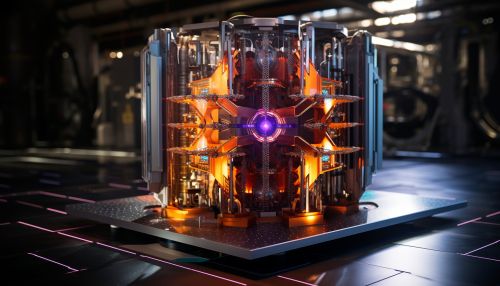The Physics of Quantum Teleportation
Introduction
Quantum teleportation is a process by which quantum information (e.g. the exact state of an atom or photon) can be transmitted (exactly, in principle) from one location to another, with the help of classical communication and previously shared quantum entanglement between the sending and receiving location. Because it depends on classical communication, which can proceed no faster than the speed of light, it cannot be used for superluminal transport or communication of classical bits. It also requires a supply of entangled particles to be shared between the sender and receiver.


Quantum Information
Quantum information is the basic entity that is transferred in the process of quantum teleportation. It is the information stored in the state of a quantum system. Quantum information differs strongly from classical information, epitomized by the bit, in many striking and unfamiliar ways. Among these are the principle of superposition, which allows quantum systems to be in multiple states simultaneously, and the principle of entanglement, which allows correlated quantum systems to be created.
Quantum Entanglement
Quantum entanglement is a physical phenomenon that occurs when a pair or group of particles is generated, interact, or share spatial proximity in a way that the quantum state of each particle cannot be described independently of the state of the other(s), even when the particles are separated by a large distance. The topic of quantum entanglement is at the heart of the disparity between classical and quantum physics: entanglement is a primary feature of quantum mechanics lacking in classical mechanics.


Quantum Teleportation Protocol
The quantum teleportation protocol is a method by which quantum information can be transmitted from one location to another. It involves three stages: preparation, transmission, and reconstruction. During the preparation stage, a pair of entangled particles is generated, one of which is sent to the sender (Alice) and the other to the receiver (Bob). In the transmission stage, Alice performs a joint measurement on her entangled particle and the particle she wishes to teleport, resulting in a pair of classical bits. She then sends these bits to Bob. In the reconstruction stage, Bob uses the classical bits to perform a unitary operation on his entangled particle, transforming it into an exact replica of the original particle.
Applications of Quantum Teleportation
Quantum teleportation has several potential applications in the field of quantum information science. These include quantum key distribution, quantum computing, and quantum networking. Quantum key distribution is a method of transmitting cryptographic keys between two parties using quantum mechanics. Quantum computing is a type of computation that uses quantum bits, or qubits, which can be in a superposition of states. Quantum networking is the use of quantum effects to perform tasks in networking, such as routing, data transmission, and link management.


Challenges and Future Directions
Despite the theoretical feasibility of quantum teleportation, there are several practical challenges that must be overcome before it can be realized on a large scale. These include the difficulty of generating and maintaining entangled particles, the need for error correction in the transmission of classical bits, and the requirement for precise control over quantum systems. Future research in quantum teleportation will likely focus on overcoming these challenges and developing new applications of the technology.


